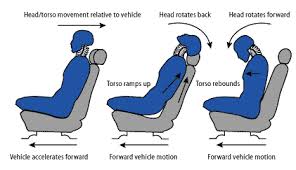The truth is that there is a proper position for the headrest that can increase your safety when riding in a car. The problem is that most people (including car dealers) don’t know what this position is, and therefore people are not properly fitted to their headrests when purchasing a new car. Before I get into the recommendations, let’s understand what happens to the body in a car accident:
In the United States, 30% of 6 million police reported vehicle crashes are rear-end collisions1. The most common symptom of whiplash or whiplash associated disorders (WAD) is pain due to mild muscle strain or mild tearing of soft tissue. Other injuries include nerve damage or damage to the intervertebral disc(2).
There is evidence that the risk of injury in rear-end collisions is independent of vehicle damage. In fact, little or no crush damage to a vehicle can result in injury with or without immediate symptoms like neck pain, headaches, back pain, etc. It has also been shown that if there is little or no movement of the head relative to the torso in a collision, people may escape neck injury even in severe crashes(2).
In a rear end collision, the head rises above the head restraint and there is a temporary straightening of thoracic (upper back) and cervical (neck) curves upon impact (Figure 1)(1). Head restraints contribute in limiting the neck distortion that occurs before the head starts to follow the torso. Effective head restraints reduce rearward motion of an occupant’s head in a rear-end crash and decrease the likelihood of sustaining a whiplash injury.

Figure 1. Effects of rear-end collision
Recommendations:
As a Walnut Creek Chiropractor I can tell you that a head restraint should be positioned at < 6cm below the top of the head or at least level with the top of the ears. The distance from the back of the head to the restraint should be as small as possible or < 6 cm from the back of the head

~Noah Kaplan, D.C.
via Jeffrey R. Scholten Professional Corp.
Practice of Upper Cervical Chiropractic
www.practiceofuppercervical.com
1. Taylor, JAM, et al. Car seat head restraint. J Can Chiropr Assoc. (2005). 49(1).
2. Insurance Institute for Highway Safety www.iihs.org
To schedule a consultation with Advance Upper Cervical Chiropractic
call 925-357-3080 or just click the button below.
if you are outside of the local area you can find an Upper Cervical Doctor near you at www.uppercervicalawareness.com.








